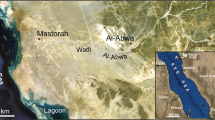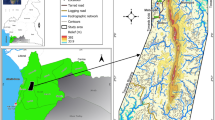Abstract
The Middle Benue Trough is a complex geologic environment consisting of a mix of sedimentary and basement rocks. It is challenged by the problem of water scarcity due to insufficient surface water sources and acute pollution of rivers and streams. Cases of borehole failures are reported during exploration for groundwater and this could be as a result inadequate geological knowledge of the major influences on the availability of groundwater, one of which is lineaments. This study, therefore, integrates the strengths of both aeromagnetic and remote sensing data to appraise the lineaments. The results obtained have important implications for groundwater search in the study area in that they confirm that higher borehole discharge rates are associated with higher density and intersection of lineaments.





Similar content being viewed by others
Data availability
The remote sensing data used were downloaded from glovis.usgs.gov. However, the magnetic data used are available with the reasonable request and with the permission of the Nigerian Geological Survey Agency.
References
Adelana SMA, Olasehinde PI, Bale RB, Vrbka P, Edet AE, Gom IB (2008) An overview of the geology and hydrogeology of Nigeria. In: Adelana SMA, MacDonald AM (eds) Applied groundwater studies in Africa. IAH selected papers in hydrogeology. Taylor and Francis, London, pp 222–259
Adepoju MO, Odeyemi IB, Akinluyi FO (2021) Landsat-8 lineament analysis for detection of epigenetic mineralization zones in parts of Igarra schist belt southwestern Nigeria. Remote Sens Earth Syst Sci. https://doi.org/10.1007/s41976-021-00046-1
Akaamaa WW, Onoja SB, Nwakonobi TU (2014) Assessment of hydro-geological formation of Obi Local Government Area of Nasarawa State for borehole setting. PAT J 10(2):168–185
Akande SO, Olusola JO, Adekeye OA, Egenhoff SO, Obaje NG, Erdtmann BD (2011) Stratigraphic evolution and petroleum potential of middle cretaceous sediments in the Lower and Middle Benue Trough, Nigeria: insights from new source rock facies evaluation. Pet Technol Dev J 1:1–34
Alisiobi AR, Ako BD (2012) Groundwater Investigation Using Combined Geophysical Methods, adapted from extended abstract prepared in conjunction with poster presentation at AAPG Annual Convention and Exhibition, Long Beach, California.
Alonso-Contes CA (2011) Lineament mapping for groundwater exploration using remotely sensed imagery in a karst terrain: Rio Tanama and Rio de Arecibo basins in the northern karst of Puerto Rico 79
Beamish D (2008) The application of tilt derivatives to EM conductivity data. In: Near Surface 2008 – 14th European Meeting of Environmental and Engineering Geophysics Kraków, Poland, 15–17
Canny J (1986) A Computational Approach to Edge Detection. IEEE Trans Pattern Anal Machine Intell 8:679–714
Constant C, Oluwagbenga OI, Orimoogunje DJ, Hlatywayo JO, Akinyede. (2013) Application of remote sensing and geographical information systems in determining the groundwater potential in the crystalline basement of Bulawayo Metropolitan Area, Zimbabwe. Adv Remote Sens 2:149–161
Cratchley CR, Jones GP (1965) An interpretation of Geology and Gravity anomalies of the Benue Valley Nigeria. Geophy Pap Overseas Geol Surv Lond 1:17–25
Dinesh AC, Markose VJ, Jayappa KS (2013) Linfo – a visual basic program for lineament density, frequency and intersection density analysis. Earth Sci Inform. https://doi.org/10.1016/j.jafrearsci.2016.04.001
Duru P (2017) Benue Government Executes 638 Water Projects in two years. Vanguard Nigeria. Retrieved from: www.vanguardngr.com/2017/07/benue-govt-executes-638-water-projects-two-years/amp/
El-Naqa A, Hammouri N, Ibrahim K, El-Taj M (2009) Integrated approach for groundwater exploration in WadiAraba using remote sensing and GIS. Jordan J Civil Eng 3(3):229–243
Fagbohun BJ, Adeoti B, Aladejana OO (2017) Litho-structural analysis of eastern part of Ilesha schist belt, southwestern Nigeria. J Afr Earth Sc 133(2017):123–137. https://doi.org/10.1016/j.jafrearsci.2017.05.017
Falebita D, Olajuyigbe O, Abeiya SS, Christopher O, Aderoju A (2020) Interpretation of geophysical and GIS-Based remote sensing data for sustainable groundwater resource management in the basement of north-eastern Osun State Nigeria. SN Appl Sci 2:1608. https://doi.org/10.1007/s42452-020-03366-x
Farrington JL (1952) A preliminary description of the Nigerian lead – zinc field. Bull Soc Econ Geol 47(6):583–608. https://doi.org/10.2113/gsecongeo.47.6.583
Fashae OA, Tijani MN, Talabi AO, Adedeji OI (2014) Delineation of Groundwater Potential zones in the crystalline basement terrain of SW-Nigeria: an integrated GIS and remote sensing approach. Appl Water Sci 4:19–38. https://doi.org/10.1007/s13201-013-0127-9
Galadima A, Garba ZN, Leke L, Almustapha MN, Adam IK (2011) Domestic water pollution among local communities in Nigeria - causes and consequences. Eur J Sci Res 52(4):592–603
Geospasial (2015) http://www.info-geospasial.com/2015/07/kombinasi-band-citra-landsat-8.html. Accessed 4 Sep 2019
Gonzalez R, Woods R (1992) Digital Image Processing. Addison-Wesley Publishing Company
Hammouri N, El-Naqa A, Barakat M (2012) An integrated approach to groundwater exploration using remote sensing and geographic information system. J Water Resour Prot 4(9):717–724. https://doi.org/10.4236/jwarp.2012.49081
Haridas VR, Aravindan S, Currish G (1998) Remote sensing and its application for Groundwater favourable area Identification. Q J GARC 6(1):18–22
Hoque M, Nwajide CS (1984) Tectono-sedimentological evolution of an elongate Intracratonic basin {aulacogen}: the case of the Benue Trough of Nigeria. J Min Geol 21(1&2):19–26
Hung LQ, Batelaan O, De Smedt F (2005) Lineament extraction and analysis, comparison of Landsat ETM and Aster imagery Case study: Suoimuoi tropical karst catchment Vietnam. Proc SPIE Remote Sens Environ Monit GIS Appl Geol. https://doi.org/10.1117/12.627699
Ibrahim U, Mutua F (2014) Lineament Extraction using Landsat 8 (OLI) in Gedo, Somali. Int J Sci Res (IJSR) 3(9):291–296
Jika HT, Mamah LI (2014) Application of electromagnetic method and electrical resistivity sounding in hydrogeological studies, a case study of Vandeikya area, central Nigeria. Int J Sci Technol Res 3(2):179–190
Kim D (2013) Sobel Operators and Canny Edge Detectors. ECE 480 Fall 2013, Team 4, pp. 33–39
King LC (1950) Outline and disruption of Gondwana land. Geol Mag 87(5):353–359. https://doi.org/10.1017/S0016756800077311
Kogbe CA (1989) The Cretaceous Paleocene Sediments of southern Nigeria. In: Kogbe CA (ed) Geology of Nigeria. Rock View Ltd Jos, pp 325–334
Mathew TG, Ariffin KS (2018) Remote Sensing Technique for Lineament Extraction in Association with Mineralization Pattern in Central Belt Peninsular Malaysia. J Phys Conf Ser 1082:012092. https://doi.org/10.1088/1742-6596/1082/1/012092
McCurry P (1976) The geology of the precambrian to lower paleozoic rocks of northern Nigeria – a review. In: Kogbe CA (ed) Geology of Nigeria. Elizabethan Publishers, Lagos, pp 15–37
Mickus, K. (2000). Magnetic Method: In: Geophysics 2000: Federal Highway Administration and Missouri Department of Transportation special publication, paper, 15 pp.
Ministry of Water Resources (2013) National water resources master plan. MWR
Mogaji KA, Omosuyi GO, Adelusi AO, Lim HS (2016) Application of GIS-based evidential belief function model to regional groundwater recharge potential zones mapping in hard rock geologic terrain. Environ Processes 3(1):93–123. https://doi.org/10.1007/s40710-016-0126-6
Murat RC (1970) Stratigraphic and paleogeography of the cretaceous and lower tertiary in southern Nigeria. In: Dessauvagie TTJ, Whiteman AJ (eds) African geology. University of Ibadan Press, Ibadan, pp 250–265
Ndougsa MT, Feumoe AN, Manguelle DE, Fairhead JD (2012) Aeromagnetic data interpretation to locate buried faults in south-east Cameroon. Geophysica 48(1–2):49–63
Nigerian Geological Survey Agency (2006) Geologic map of Nigeria. Geological Survey Department: Ministry of Petroleum and Mineral Resources, Abuja
Nwachukwu SO (1972) The tectonic evolution of the southern portion of the Benue Trough. Nigeria Geol Mag 109:411–419. https://doi.org/10.1017/S0016756800039790
Nwosu OB (2015) Qualitative interpretation of aeromagnetic data over parts of Middle Benue Trough Nigeria using HRAM. Stand Sci Res Essays 3(2):026–032
Obaje NG (2004) Geology and Mineral resources of Nigeria. Springer, Dordrecht, p 224
Obiora SC (2012) Chemical characterization and tectonic evolution of hornblende-biotite granitoids from the Precambrian basement complex around Ityowanye and Katsina-Ala, southeastern Nigeria. J Min Geol 48(1):13–29
Offodile ME (1983) The occurrence and exploitation of groundwater in Nigerian Basement Rocks, Nigerian. J Min Geol 20(1&2):131–146
Offodile ME (2002) Groundwater study and development in Nigeria. Mecon Geology and Engineering Services Ltd., Jos
Ogundana AK, Talabi AO (2014) Groundwater potential evaluation of college of engineering, Afe Babalola University, Ado-Ekiti, Southwestern Nigeria. Am J Water Resour 2(1):25–30
Ominigbo OE (2022) Evolution of the Nigerian basement complex: current status and suggestions for future research. J Min Geol 58(1):229–236
Phillips JD (2002) Processing and interpretation of aeromagnetic data for the Santa Cruz Basin–Patagonia Mountains Area, South-Central Arizona: U.S. Geological Survey Open-File Report 02–98. https://pubs.usgs.gov/of/2002/0098/.
Rao BV, Briz-Kishore BH (1991) A methodology for locating potential aquifers in a typical semi-arid region in India using resistivity and hydrogeologic parameters. Geoexploration 27(1–2):55–64. https://doi.org/10.1016/0016-7142(91)90014-4
Shrivakshan GT, Chandrasekar C (2012) A comparison of various edge detection techniques used in image processing. Int J Comput Sci Issues 9(5):269–276
Si Mhamdi H, Raji M, Maimouni S, Oukassou M (2017) Fractures network mapping using remote sensing in the Paleozoic massif of Tichka (Western High Atlas, Morocco). Arab J Geosci. https://doi.org/10.1007/s12517-017-2912-5
Tam VT, De Smedt F, Batelan O, Dessarguess A (2004) Study on the relationship between lineaments and borehole specific capacity in a fractured and karstified limestone area in Vietnam. Hydrogeol J 12(6):662–673. https://doi.org/10.1007/s10040-004-0329-1
Terhemba BS, Daniel O, David M, Chukudebelu JU, Ezema PO (2016) Aquifer characterization and classification using electromagnetic and galvanic resistivity methods in basement complex, Katsina-Ala central Nigeria. Int J Sci Technol 4:10–21
Toteu SF, Penaye J, Djomani YP (2004) Geodynamic evolution of the Pan-African belt in central Africa with special reference to Cameroon. Canad J Earth Sci 41(1):73–85. https://doi.org/10.1139/E03-079
Umeh EU, Hassan M, Onekutu A (2004) Host-related risk factors associated with asymptomatic bacteriuria in a rural community in Benue State, Nigeria. Niger J Microbiol 20:873–879
Van der Meer FD, Van der Werff HMA, Van Ruitenbeek FJA, Hecker CA, Bakker WH, Noomen MF et al (2012) Multi- and hyperspectral geologic remote sensing: a review. Int J Appl Earth Observ Geoinf 14(1):112–128. https://doi.org/10.1016/j/jag.2011.08.002
Verduzco B, Fairhead JD, Green CM, MacKenzie C (2004) New insights into magnetic derivatives for structural mapping. Lead Edge 23(2):116–119
Wendt L, Hilberg S, Robl J, Dirnberger D, Strasser T, Braun A (2016) Remote sensing in hydrogeology: a short summary of methods and constraints for groundwater exploration. Technical Report, University of Salzburg and University of Tubingen, Germany, pp 57. Project EO4HumEn. www.zgis.at/humanitarian-services.
Acknowledgements
The authors wish to acknowledge that the remote sensing data was downloaded from glovis.usgs.gov while the magnetic data was provided by the Nigerian Geological Survey Agency (NGSA).
Author information
Authors and Affiliations
Corresponding author
Ethics declarations
Conflict of interest
There is no conflict of interest with respect to this study.
Additional information
Publisher's Note
Springer Nature remains neutral with regard to jurisdictional claims in published maps and institutional affiliations.
Rights and permissions
Springer Nature or its licensor (e.g. a society or other partner) holds exclusive rights to this article under a publishing agreement with the author(s) or other rightsholder(s); author self-archiving of the accepted manuscript version of this article is solely governed by the terms of such publishing agreement and applicable law.
About this article
Cite this article
Falebita, D.E., Ayua, K.J. Appraisal of lineaments for groundwater prognosis in the Middle Benue Trough, Nigeria: a case study. Sustain. Water Resour. Manag. 9, 12 (2023). https://doi.org/10.1007/s40899-022-00791-1
Received:
Accepted:
Published:
DOI: https://doi.org/10.1007/s40899-022-00791-1




